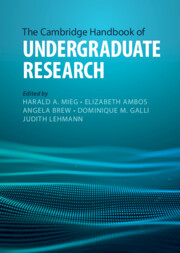Book contents
- The Cambridge Handbook of Undergraduate Research
- The Cambridge Handbook of Undergraduate Research
- Copyright page
- Contents
- Figures
- Tables
- Contributors
- Foreword
- Foreword
- 1 Introduction
- Part I Theory and Research on Undergraduate Research
- Part II Implementation, Approaches, Methods
- Part III Disciplines
- Part IV International Perspective
- 47 Introduction
- Part IV.1 Americas
- Part IV.2 Africa & Middle East
- Part IV.3 Asia & Oceania
- 58 Undergraduate Research in China
- 59 Undergraduate Research in India
- 60 Undergraduate Research in Indonesia
- 61 Undergraduate Research in Japan
- 62 Undergraduate Research in Australia
- 63 Undergraduate Research in New Zealand
- Part IV.4 Europe
- Part V Avenues for Developing Undergraduate Research
- Index
- References
60 - Undergraduate Research in Indonesia
Prospects and Challenges
from Part IV.3 - Asia & Oceania
Published online by Cambridge University Press: 11 August 2022
- The Cambridge Handbook of Undergraduate Research
- The Cambridge Handbook of Undergraduate Research
- Copyright page
- Contents
- Figures
- Tables
- Contributors
- Foreword
- Foreword
- 1 Introduction
- Part I Theory and Research on Undergraduate Research
- Part II Implementation, Approaches, Methods
- Part III Disciplines
- Part IV International Perspective
- 47 Introduction
- Part IV.1 Americas
- Part IV.2 Africa & Middle East
- Part IV.3 Asia & Oceania
- 58 Undergraduate Research in China
- 59 Undergraduate Research in India
- 60 Undergraduate Research in Indonesia
- 61 Undergraduate Research in Japan
- 62 Undergraduate Research in Australia
- 63 Undergraduate Research in New Zealand
- Part IV.4 Europe
- Part V Avenues for Developing Undergraduate Research
- Index
- References
Summary
Indonesia is the fourth most populous country in the world after China, India, and the USA, and its population will continue to grow in coming years. With a population of more than 270 million, and bracing for the “demographic bonus” in 2030, in which the number of people at the productive age is predicted to reach its highest ever peak, Indonesia is witnessing a higher growth rate among its student population than its overall population. The number of university graduates in 2019 was 1,756,239 and is predicted to grow each year. In 2019, Indonesia had 4,711 higher education institutions (HEIs) registered by the Ministry of Education and Culture, of which only 122 were public institutions. However, 49 percent of the annual student intake in that year went to public HEIs (876,458), while the rest went to private institutions (1,084,634), clearly demonstrating the highly competitive nature of public HEIs in general (Kementerian Riset, Teknologi, dan Pendidikan Tinggi, 2019).
- Type
- Chapter
- Information
- The Cambridge Handbook of Undergraduate Research , pp. 549 - 556Publisher: Cambridge University PressPrint publication year: 2022



